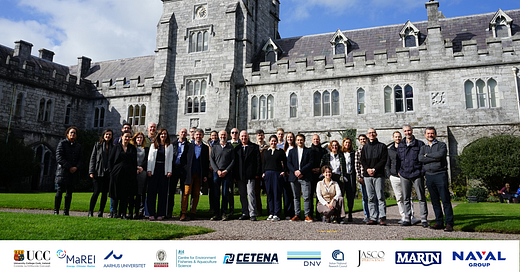SATURN: A Year in Review!
Catch up on the SATURN project's research activities in this year's project newsletter!
Welcome to our third annual project newsletter! Below you’ll find articles from our project partner institutions that describe the the work they have been undertaking in the last 12 months! We hope you enjoy them!
— The SATURN Consortium
https://www.saturnh2020.eu/
Contents
Scroll to read the articles below, or view each article individually on our website via the following links:
Designing Propellers for Low URN
By Evert-Jan Foeth (MARIN)
Towards a Procedure to Predict Ship Underwater Radiated Noise Mitigation by Air Injection
By Thomas Lloyd, Frans Hendrik Lafeber and Johan Bosschers (MARIN)
Some Exciting Updates from our Partners at TNO
By Christ de Jong and Boudewijn van den Bosch (TNO)
Detection of Vessel Passes in Acoustic Tags on Short-Finned Pilot Whales from the Canary Islands
By Marín, O., Rubio, C., Arranz, P., Johnson, M. and Aguilar de Soto, N. (University of La Laguna)
Keeping Up To Date With Our Partners At TIHO
By Dominik André Nachtsheim, Jeff Schnitzler, Nina Maurer, Joy Ometere Boyi, Luca Aroha Schick and Maria Morell (TIHO)
International Maritime Organization Workshop
By Eric Baudin (Bureau Veritas)
Designing Propellers for Low URN
By Evert-Jan Foeth (MARIN)

Within SATURN the automatic propeller design and optimization suite used at MARIN for day-to-day engineering was updated to estimate the RNL of the cavitation propeller. This suite uses bio-inspired multi-objective optimization algorithms able to balance competing goals while satisfying a range of stringent constraints; successive generations of designs are generated, improving with each iteration. The first goal was maximization of the propeller efficiency, an indicator of the expected power use and, indirectly, green-house gas emissions.
The results from each propeller analysis were coupled to a series of empirical relations estimating the sound of the sheet and tip vortex cavitation, plus, the tonal contribution at the blade rate frequencies. The total RNL was then corrected by the weighting functions for various mammalian hearing groups from (Southall et al., 2019). The second goal was set to the minimization of the highest weighted RNL levels.
A number of constraint were set to the design process following best-practice engineering guidelines, primarily aimed at obtaining low cavitation erosion risk, satisfying class regulations of blade strength and avoiding flow separation. The method was applied to a twin screw ferry with controllable pitch propellers. To ensure a robust design, each propeller was analyzed at the nominal and maximum rating of both engines per shaft, as well as the nominal rating using only one engine per shaft. These conditions force the propeller to operate at both over and underloading conditions where cavitation may appear on either side of the blade, limiting the viable design space. With a constant rate of revolutions, the blades of the controllable pitch propellers were automatically rotated such that all these conditions were met for any geometry.
Towards a Procedure to Predict Ship Underwater Radiated Noise Mitigation by Air Injection
By Thomas Lloyd, Frans Hendrik Lafeber and Johan Bosschers (MARIN)

Last year, in Issue 2 of SATURN’s Research Newsletter, we reported on the scale model tests performed at MARIN to study the performance of two air injection systems for reducing ship underwater radiated noise. These are the Masker system, aimed at mitigating machinery noise by isolating the vibrating hull plating from the surrounding water, and the Prairie-like system, whereby bubbles are injected into the propeller cavitation with the aim of dampening the cavity collapse (a dominant sound generation mechanism). The laboratory measurements were made in MARIN’s Depressurised Wave Basin facility, with the scale models – incorporating in-house developed air injection systems – towed through the water by a carriage and sound measured using hydrophones mounted in the basin.
We previously presented preliminary results for the changes in sound level spectra for each system for a selected test condition. For the Prairie-like system, we call this the ‘source level attenuation’, where source level refers to the magnitude of the sound generated by a particular source, or combination of sources. This name was chosen since the Prairie-like system reduces (or changes) the source level strength by dampening the implosion of the cavitation. However, the equivalent term for the Masker system is `insertion loss’, since the change in measured sound level results from the air bubble layer being ‘inserted’ between the vibrating hull and the water.
Some Exciting Updates from our Partners at TNO
By Christ de Jong and Boudewijn van den Bosch (TNO)
2024 was another busy year for TNO in the SATURN project. The core of our work is in WP2 where TNO and JASCO are jointly developing the capability to create maps that represent the particle motion component of underwater sound from ships, to enable quantifying the potential impact of shipping sound on fish and invertebrate species that are more sensitive to sound particle motion than to sound pressure.
2022 Particle Motion Measurements
The results from the 2022 particle motion measurements in the shallow coastal water outside the port of Scheveningen were analysed. Measurements with a controlled sound source (airgun) were compared against model predictions. The above figure, shows an example of modelled propagation loss for sound pressure and sound particle velocity for the airgun measurements. This illustrates that the radial sound particle velocity field is very similar to the sound pressure field. At most locations, not too close to the source, the water surface or the seabed, the radial sound particle velocity can be estimated by scaling the sound pressure with a constant factor (the characteristic impedance of sea water). At distance not too close to the source, the vertical sound particle velocity is much smaller (the propagation loss much higher) than the radial sound particle velocity.
Status of ISO 17208-3
SATURN WP2 also supports the ISO working group that is developing a new standard procedure for measurements of ships in shallow water (ISO 17208-3). The international group of experts, led by Christ de Jong (TNO), produced a Draft International Standard (DIS) that was distributed for ballot by the participating ISO members in October 2023. All members voted in favour of this DIS, so that the group can now start processing the remaining comments towards publication of the standard.
Detection of Vessel Passes in Acoustic Tags on Short-Finned Pilot Whales from the Canary Islands
By Marín, O., Rubio, C., Arranz, P., Johnson, M. and Aguilar de Soto, N. (University of La Laguna)

We are excited to announce the latest findings from our ongoing research project at the University of La Laguna in the Canary Islands, Spain. After analyzing the data obtained from 21 deployed DTAGs over 117.5 hours on individuals of short-finned pilot whales (Globicephala macrorhynchus), we present the preliminary results of our ship passage analysis within the Special Area of Conservation (SAC) Teno-Rasca and its surroundings off the island of Tenerife.
Firstly, we conducted a pilot study involving four (N = 4) individuals. This is the first pilot study using acoustic data gathered with onboard tags attached to deep-diving echolocating whales to assess the exposure of these whales to ship noise. The study presented instances of short-finned pilot whales encountering daily exposure to noisy boat passages. We devised a supervised detector for vessel passages, capable of identifying up to 11 passages within 50.5 hours of recording, within the Third Octave Level (~decidecade level) of 5Hz. During these events, sound levels reached 105 and 115 dB re. 1 μPa, within and outside the SAC, respectively. Remarkably, this method proved effective despite the fluking noise produced by the whales and the broadband echolocating clicks in the four recordings. The findings of this pilot study were showcased at the OCEANOISE Conference held in May 2023, in Barcelona, Spain.
Keeping Up to Date With Our Partners at TIHO
By Dominik André Nachtsheim, Jeff Schnitzler, Nina Maurer, Joy Ometere Boyi, Luca Aroha Schick and Maria Morell (TIHO)
In close collaboration with Aarhus University, researchers at the Institute for Terrestrial and Aquatic Wildlife Research at the University of Veterinary Medicine Hannover (TIHO) have developed an automated tool to detect events of elevated underwater noise in animal-borne sound recordings and subsequently identify vessel passes. The development of an automated workflow has been essential to efficiently process sound data from tag deployments lasting over several days and weeks. The tool was applied to quantify vessel noise exposures from previous deployments of DTAGs on nine harbour seals from the Wadden Sea. The work was published in Scientific Reports and revealed that harbour seals are repeatedly exposed to vessel noise, on average four times per day. Another major discovery was that only one third of the encounters could be reasonably attributed to a nearby AIS-registered vessel identified from publicly accessible AIS databases. This finding emphasises the importance of using DTAGs as noise dosimeters to quantify vessel noise exposures and demonstrates that AIS data are an insufficient predictor of vessel noise impacts.
Furthermore, TIHO researchers have deployed additional 3 DTAGs on harbour seals in the Elbe estuary within the frame of SATURN. Data analysis is still ongoing but initial assessments clearly show that these seals live in a highly industrialised habitat with a high degree of maritime traffic. They are exposed to vessel noise much more frequently than seals outside the estuary. The implications of living in this noisy habitat, especially in light of increased disturbances and related fitness consequences, are still subject of investigations.
In this context, the health investigations on the tagged harbour seals become extremely valuable. TIHO researchers have performed clinical health assessments on all tagged harbour seals from the Elbe as well as on the previous deployments in the Wadden Sea.
International Maritime Organization Workshop
By Eric Baudin (Bureau Veritas)
For those who missed our SATURN partners speaking at the IMO Workshop (18-19 September) on the “Relationship Between Energy Efficiency and Underwater Noise Radiated from Ships”, their presentations can now be downloaded, along with all other relevant documentation from the IMO Website!
Publications
Vessel Noise Exposures of Harbour Seals from the Wadden Sea (Scientific Reports, 2023).
Small Reductions in Cargo Vessel Speed Substantially Reduce Noise Impacts to Marine Mammals (Science Advances, 2023).
Is Maritime Spatial Planning a Tool to Mitigate the Impact of Underwater Noise? A Review Adopted and Upcoming Maritime spatial Plans in Europe (Marine Policy, 2023).
Ship Noise Causes Tagged Harbour Porpoises to Change Direction or Dive Deeper (Marine Pollution Bulletin, 2023).
Modelling Sound Particle Motion in Shallow Water (The Journal of Acoustical Society of America, 2023).
Final Report on Vessel URN Measurements (SATURN Project Technical Reports, 2024).
SATURN Deliverable 4.3: Impact of Mitigation Measures on Source Level of a Single-screw Vessel (SATURN Project Technical Reports, 2024).
Statocyst Ultrastructure in the Norwegian Lobster (Nephrops norvegicus) (Biology, 2024)
SATURN is an EU-funded project researching solutions to the problem of underwater radiated noise caused by shipping and other vessels. Learn more about SATURN at www.saturnh2020.eu.
















